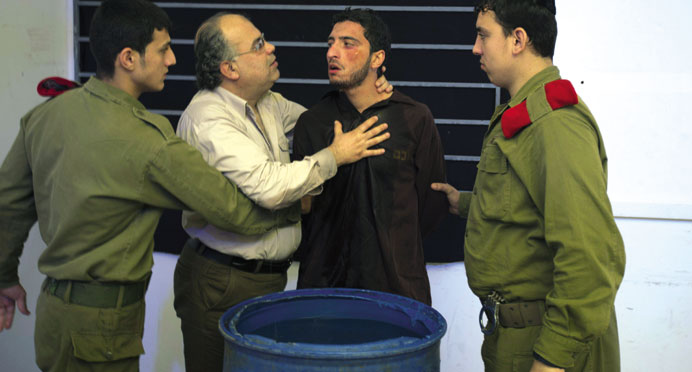Actors performing during the shooting of the film, Fleeting Illusion, in Gaza City. The first scenes of the film depict an Israeli cell where Hamas fighter Mustafa Muammar, played by journalist student Mohamed Radhi, is being questioned after his capture by Israeli troops on the eve of the Shalit raid. Muammar’s interrogators, played by fellow Gazan actors, plunge his head into a bucket of water to try to make him cough up information that could compromise the operation planned for the next day.
By Adel Zaanoun /Gaza City/AFP
A young Israeli soldier captured by Gaza militants and held for five years before being traded for hundreds of Palestinian prisoners is the subject of an ambitious low-budget film being made by his captors.
The fate of Gilad Shalit, a corporal captured in a deadly cross-border raid when he was just 19, transfixed Israel for years as his captivity in an unknown location challenged what most Israelis see as the state’s sacred duty to bring its soldiers home.
But for the Hamas movement ruling Gaza, his capture and eventual exchange for more than 1,000 prisoners was a triumph for the “resistance”, an epic worthy of a blockbuster feature - even if produced on a shoestring budget.
A shortage of funds has drastically slowed the production, and even its director said it may not live up to the high-quality epic envisioned.
Entitled Fleeting Illusion, the 90-minute film promises revelations about Shalit’s capture and top-secret captivity “about which neither Shalit nor the resistance have spoken before”, director and screenwriter Majed Jundiyeh told AFP.
Jundiyeh, who says he is not a member of Hamas, made the 2009 biopic Emad Akel about a commander of Hamas’s military wing who headed Israel’s hit list until he was killed in 1993.
Filming on his latest work began in December, and the first of the film’s two parts was to have been ready for the eighth anniversary of Shalit’s June 2006 capture by Hamas and two other groups, whose fighters tunnelled into Israel and attacked a border post.
Shalit was eventually released in October 2011 in exchange for 1,027 Palestinians.
Gilad’s father Noam Shalit, who was long the public face of the campaign for his release, declined to speak about the film, saying he did not want to “engage in a dialogue with Hamas”.
“The story is behind us,” he said.
The first scenes of the film were shot in a small room at the ministry of prisoners’ affairs, depicting a dark Israeli cell where Hamas fighter Mustafa Muammar is being questioned after his capture by Israeli troops on the eve of the Shalit raid.
Muammar’s interrogators, played by fellow Gazan actors, plunge his head into a bucket of water to try to make him cough up information that could compromise the operation planned for the next day.
“I dream that this film on Shalit will make me known in the world,” says the actor playing Muammar, 21-year-old Mohamed Radhi, a journalism student by day.
His interrogator is played by Mohamed Abu Qumsane, son of a resistance fighter killed by Israel.
“I love being an actor because it is a way of expressing the issue of prisoners with humanity,” he says.
Most of the cast of 40, among them 12 women, are amateurs, says Jundiyeh, who himself plays an Israeli officer.
He says that Mohamed Qarara, cast in the role of Shalit, gets paid “no more than 2,000 shekels ($570) a month”.
The film will by necessity be a low-budget affair, in part because Shalit’s capture prompted Israel to impose a blockade on Gaza that remains to this day, though some of the restrictions have been eased in recent years.
The initial budget for the film, produced by the Hamas government’s culture ministry, was slated at $2.5mn, but Jundiyeh eventually had to settle for a frugal $320,000.
“It could show in the (film’s) quality,” he admitted.
“The Iranian ministry of culture had been expected to finance the film but its support stopped because of deteriorating relations between Iran and Hamas over the situation in Syria,” Jundiyeh said.
Tehran supports Syrian President Bashar al-Assad while Hamas, which long maintained a Damascus headquarters, turned on the regime following the 2011 uprising.
But Gaza’s culture minister, Mohamed al-Madhun, insists that bridges with Iran have not been burned and that there is a joint project under way to make a feature film about the devastating 22-day Israeli campaign against Hamas launched in December 2008.
He said the film captures “the special atmosphere of keeping watch on Shalit, his concealment and relaxed moments on a Gaza beach illustrating civilised and humane treatment of prisoners”.
Gaza resident Noha Nassar said he would like to see the film and learn how Shalit’s captors kept him hidden for so long in the narrow coastal strip, which is nearly surrounded by Israeli forces and closely monitored by aerial drones.
But with Gaza’s cinemas having been destroyed by militants several years ago, the film is likely to be screened only by the few cultural institutions still functioning, before being broadcast on local TV.

